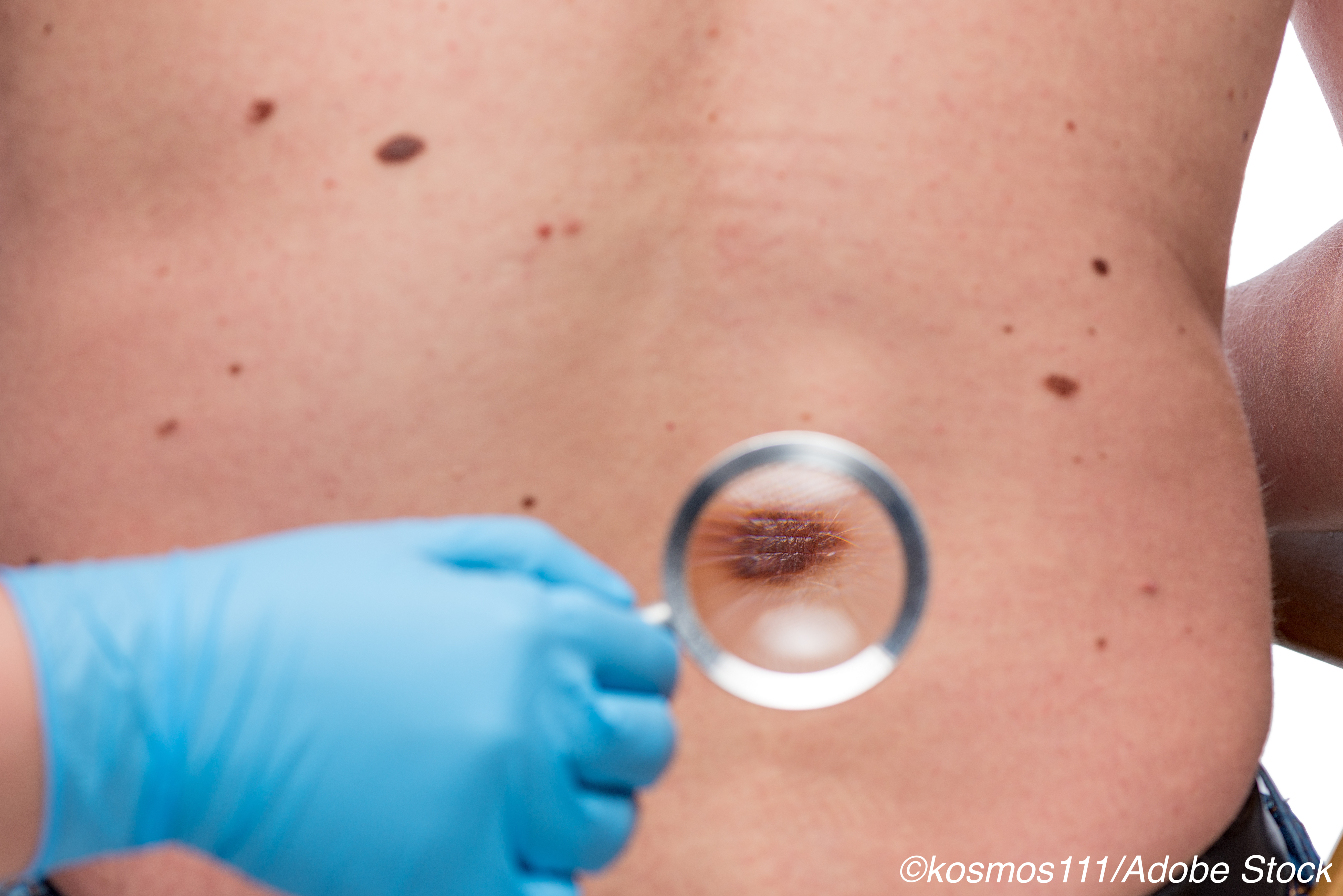
Two currently available gene expression profile (GEP) tests performed poorly at identifying patients with cutaneous melanoma at risk for recurrence, especially those with stage 1 disease, a systemic review and meta-analysis has shown.
In an analysis of 7 studies involving 1,450 patients, the number of false-negative results where the recurrence of melanoma was incorrectly classified as “low-risk” was high in patients with stage 1 melanoma, Michael Marchetti, MD, Memorial Sloan Kettering Cancer Center in New York, and colleagues reported in JAMA Dermatology.
And, in fact, the false-positive rate in the same group of patients was 10-fold more frequent than true-positive results, investigators pointed out.
Furthermore, the number of false-positive results where melanoma without recurrence was incorrectly classified as “high-risk” was also high in patients with stage 2 disease, investigators noted.
“[H]ealth care professionals are using GEP tests to inform patient care decisions, but the settings in which they have clinical utility are not clear,” Marchetti and colleagues pointed out.
“[Our] study found that the prognostic ability of DecisionDx-Melanoma and MelaGenix to predict recurrence among patients with localized melanoma varied by AJCC (American Joint Committee on Cancer) stage and appeared to be poor for patients with stage I disease,” they concluded.
The 7 studies analyzed were all observational and almost all had a high risk of bias, as the authors cautioned.
Four studies involved 623 patients with stage I disease.
Six patients had a true positive on the DecisionDx-Melanoma test; 15 had false-negative results; 61 had false-positive results, and 541 had true-negative results.
Three percent of this group of stage I patients developed recurrence.
Of these, 29% had a high-risk GEP test score, which worked out to 2% (95% CI, 2-49%) on the meta-analysis, researchers reported.
Of the 97% who did not develop recurrence, 90% had a low-risk score on the same GEP test, the estimated proportion of which was 91% (95% CI, 87-94%) on the meta-analysis.
Another 4 studies involved 212 patients with stage II disease, 59 of whom had true-positive results; 13 of whom had false-negative results; 78 of whom had false-positive results and 62 of whom had true-negative results.
Some 34% of this group of stage II patients developed recurrence, as the authors noted.
Of these, 82% had a high-risk GEP test score, which worked out to an estimated proportion of 84% (95% CI, 73-92%) on the meta-analysis.
Almost two-thirds of patients (66%) of those with stage II disease did not develop recurrence, as the authors noted.
Among these, 44% had a low-risk score on the GEP which was the same estimated proportion on the meta-analysis (95% CI, 36-53%).
Five studies contributed 1117 partially overlapping patients with stage I or stage II disease.
In this group, 76 patients had true-positive results; 31 had false-negative results; 186 had false-positive results, and 824 had true-negative results.
Ten percent of this group of partially overlapping patients developed recurrence, among whom 71% had a high-risk GEP test score, the estimated proportion of which was 75% (95% CI, 63-86%) on the meta-analysis.
Among the 90% of partially overlapping patients who did not develop recurrence, 82% had a low-risk score, which worked out to an estimated proportion of 81% (95% CI, 76-86%) on the meta-analysis.
When analyzing results obtained on the MelaGenix GEP (only available in Europe), one study reported on 88 patients with stage I disease.
Out of this small group, 7 had true-positive results; 15 had false-negative results; 15 had false-positive results, and 51 had true-negative results.
Twenty-five percent of this group of patients developed recurrence among whom 32% had a high-risk GEP score on the MelaGenix test.
Among the 75% who did not develop recurrence, 77% had a low-risk GEP score.
Another study reported on 245 patients with stage II disease, among whom 59 had true-positive results; 19 had false-negative results; 95 had false-positive results, and 72 had true-negative results.
Some 32% of this group of patients with stage II disease developed recurrence, 76% of whom had a high-risk GEP score; of those who did not develop recurrence, only 43% had a low-risk GEP score.
As the authors noted, it is important to assess GEP test performance in the context of other known clinicopathologic factors for cutaneous melanoma assessment.
These factors include age, sex, tumor location and thickness, ulceration, mitotic rate, lymphovascular invasion, microsatellites and most importantly, sentinel lymph node biopsy status, as they detailed.
“The aim of such an analysis would be to identify patients for whom the GEP test adds clinically significant prognostic information leading to a change in treatment,” Marchetti and colleagues observed.
“[Since m]ost patients with stage I disease with melanoma events were incorrectly classified as being at low risk for recurrence by GEP tests…these tests are unlikely to alter management and/or reduce mortality at the population level,” they added.
In a related study, Douglas Grossman, MD, PhD, Huntsman Cancer Institute in Salt Lake City, Utah, and other members of the Melanoma Prevention Working Group (MPWG) concurred with the authors that that the test performance of currently available GEP tests is limited in patients with stage I cutaneous melanoma.
Having reviewed the evidence and recommendations for the use of GEP testing in this patient setting, “[t]he consensus of the MPWG is that there are insufficient data to support routine use of currently available prognostic GEP tests to inform management for patients with CM (cutaneous melanoma),” they stated.
The group thus recommended more research be carried out to better assess the validity and clinical applicability of current and future GEP tests.
In an accompanying editorial, Warren Chan, MS, Stanford University School of Medicine, Stanford, California, and Hensin Tsao, MD, PhD, Massachusetts General Hospital, Boston, Massachusetts, reminded readers that GEP measures levels of multiple genes in a patient’s tumor to predict clinical outcome.
However, GEPs are not yet endorsed by either the American Academy of Dermatology or by the National Comprehensive Cancer Network even though approximately 12,000 DecisionDx-Melanoma tests are processed every year in the U.S. and their use is increasing.
Still, as the editorialists argued, mortality from melanoma has changed substantially in the recent past as a result of improvements in both molecular and immune therapies.
Thus, “prognosis no longer predicts overall survival,” as Chan and Tsao stated.
Given that GEP tools are constructed on older retrospective data, “a more contemporary goal for GEP would be decision-making in terms of therapeutic eligibility based on drug response and toxic effects,” the editorials observed.
In the meantime, what should dermatologists do when considering GEP use for patients with melanoma?
Firstly, “think twice” before ordering GEP tests for patients with a T1a melanoma that is under 0.8 mm and nonulcerated, as the editorialists suggested.
For these patients, 5- and 10-year melanoma–specific survival rates are 99% and 98%, respectively—excellent outcomes which GEP tests will unlikely change significantly, they pointed out.
“Second, gene panels will likely work only for specific outcomes,” Chan and Tsao cautioned.
So, a gene panel that predicts survival may not work to classify patients at risk for nodal metastases because survival and nodal metastases may be distinct, as they emphasized.
“Even if you use GEP testing and discover a low-risk class assignment for a 2.0 mm-thick melanoma, avoid the urge to bypass the sentinel lymph node discussion altogether,” Chan and Tsao warned.
“Nodal sampling, for good reasons, remains part of all major guidelines and determines eligibility for adjuvant treatments,” they emphasized.
-
Currently available gene expression profile tests performed poorly at identifying recurrence risk in cutaneous melanoma patients.
-
Data do not yet support the routine use of prognostic GEP tests for the management of stage I and II cutaneous melanoma.
Pam Harrison, Contributing Writer, BreakingMED™
Marchetti reported being a member of the Melanoma Prevention Working Group.
Grossman reported receiving personal fees from Orlucent.
Chan reported receiving personal fees from Howard Hughes Medical Institute.
Tsao had no conflicts of interest to report.
Cat ID: 11
Topic ID: 75,11,497,730,11,120,26,192,925


